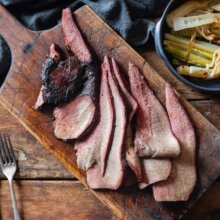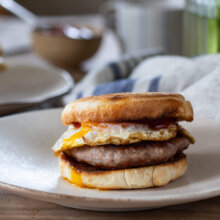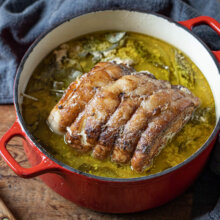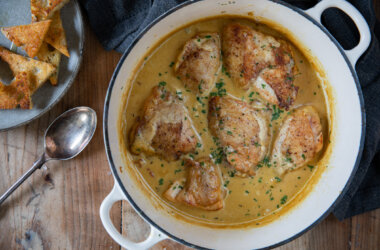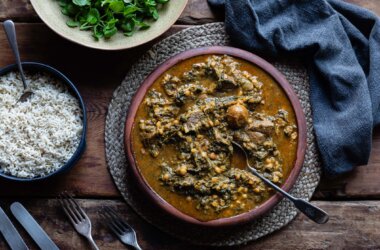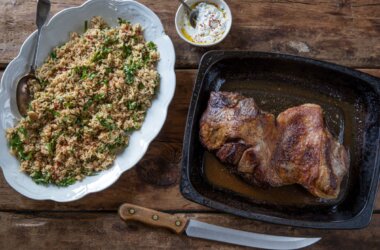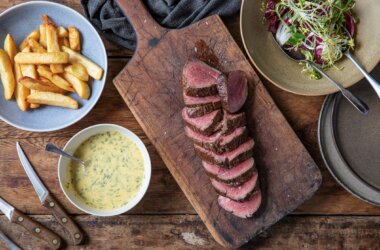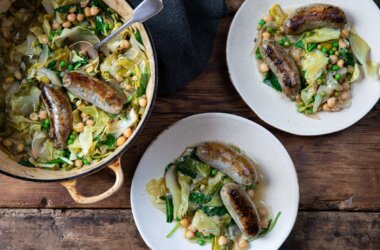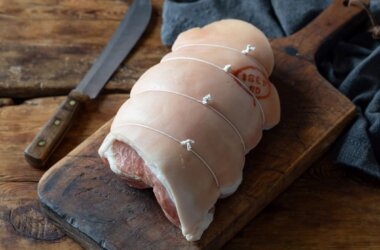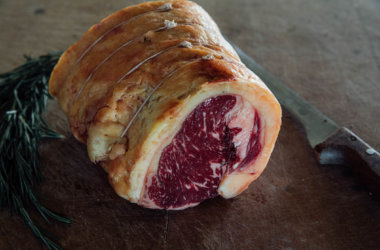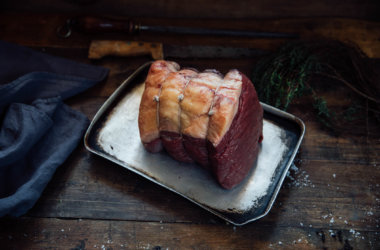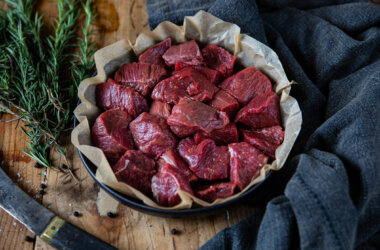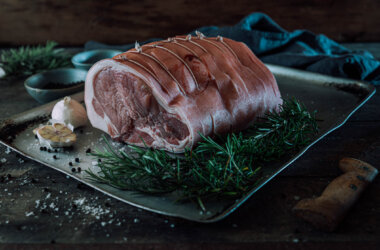This wonderful, celebratory bird finds itself at the centre of an Italian inspired, Christmas feast.
When it comes to Christmas dinner, people often ponder whether this is finally the year to cook something other than a turkey and all the trimmings. Well, here is a recipe that mixes things up a touch, but not so much that it doesn’t feel like Christmas. The Marsala and chestnuts come together, along with the cockerel juices to create a fabulous, rich and distinctly ‘Christmassy’ gravy. Then there is a stuffing, which if it wasn’t for the quality of the bird, would be the star of the show; with mortadella and parmesan giving it an umami kick. Most people, of course, end up reverting to the norm, and there is no shame in that, for a roasted turkey and all the trimmings is both delicious and loaded with nostalgia for Christmases past. But for those out there who do want to take the plunge this year, then this is a winner (of course you can add some roast potatoes if you fancy too!).

Serves 8
Ingredients
For the kale
For the stuffing
For the braised lentils
For the roasted pumpkin:
Method
- The first step in this adventure is most definitely to get your cockerel out of the fridge. I would suggest on Christmas Eve before you go to bed, or if not, then first thing in the morning.
Starting with the stuffing of the bird:
- Tip the pork mince into a bowl and add the mortadella, Parmesan, chopped rosemary, a good twist of white pepper, a grating of nutmeg and a pinch of salt. Mix all together.
- In a small pan, sweat off the shallots and garlic in the butter until soft and translucent. Allow to cool and then add to the mince.
- Squeeze the milk out of the bread and then add to the bowl along with the two eggs. Using your hands, mix everything together thoroughly, then take a little and fry gently in a pan. Taste for seasoning and adjust as necessary.
- Season the inside of the cockerel with a little sea salt and then add the stuffing, making sure to leave a little space at the top of the cavity for hot air to circulate. No more than three quarters full.
- Pre-heat your oven to 180°C.
- Find a roasting tray big enough to house the bird and scatter the chestnuts around the bottom. Then add the Marsala and 300ml of chicken stock.
- Rub the bird all over with olive oil and then season with sea salt. Place the bird in the middle of the tray and then the whole tray into the oven for 1 hour.
- Reduce the heat to 160°C and cook for a further 1 ½ – 2 hours.
- Remove the bird from the oven and leave to rest, somewhere warm, for at least 1 hour.
For the lentils:
- Take a large, heavy bottomed pan and on a medium heat with 2 tablespoons of olive oil add the lardons. Stirring regularly, let them brown whilst also rendering out their fat. Once browned and swimming in lovely fat, add the onions, carrots, garlic, celery, celeriac and a good pinch of salt. Cook this with a lid on, over a low heat for about 20 minutes, stirring frequently. You want the veg to be soft and just beginning to colour a little; at which point add the lentils and the red wine. Bring the wine to the boil and then simmer for a couple of minutes before adding the chicken stock, herbs and 3 more tablespoons of extra virgin olive oil, plus another pinch of salt. Allow this to come up to the boil and then reduce to a simmer. Cover with a lid and simmer for about 45 minutes, stirring occasionally. If at any point it is looking a bit dry, then add a dribble more chicken stock.
- Check the lentils. I personally don’t like my lentils al dente (although some people do, apparently), they should be soft and almost creamy, but importantly, not complete mush. Check the seasoning and adjust if necessary – I find a good splash of sherry (or any other good vinegar) is what’s needed.
To roast the pumpkin:
- Turn the oven back up to 180°C.
- Using a sharp knife, cut the pumpkin or squash into large wedges and lay in a roasting dish. Be careful not to overfill the tray, as this will prevent even cooking. Use two trays if needed.
- Season well with seat salt and black pepper and then liberally drizzle olive oil over.
- Scatter the garlic cloves and sage and mix everything together. Then scatter over the cubed butter and transfer to the oven. Roast for 25 minutes.
- Remove from the oven and test the squash, the flesh should be tender when prodded with a small knife. Return to the oven if it needs a little more cooking.
For the kale:
- Bring a pan of salted water to the boil.
- Blanch the kale for 2 minutes, in batches if necessary, and then drain in a colander.
- In a separate, large, heavy bottomed pan, add 5 tablespoons of olive oil and set over a medium heat. Once the oil is hot add the garlic, a small pinch of chilli flakes and a pinch of salt. Cook the garlic until it becomes ‘sticky’ – you will notice the spoon start to feel sticky and the slices of garlic sticking together.
- Add the kale and stir well. Cook over a medium heat for 3-4 minutes.
- Check the seasoning and adjust as necessary.
For the gravy:
- Remove the cockerel from the tray it was roasted in and transfer to a platter. As you remove the bird, make sure to let all the juices run off into the roasting tray.
- Heat 300ml of chicken stock in a small pan.
- Set the roasting tray over a medium heat (if it is suitable for direct heat, otherwise transfer to a pan) and once the liquid (with the chestnuts in it) is simmering, add a tablespoon of plain flour and mix well.
- Then add the hot stock whilst stirring continuously. Once all the stock is added, allow the gravy to simmer on a low heat for 10 minutes, stirring regularly.
- Check the seasoning and adjust as necessary.
- Decant to a gravy boat, with all the chestnuts.
- Gather everyone around the table, pour the wine and serve.
